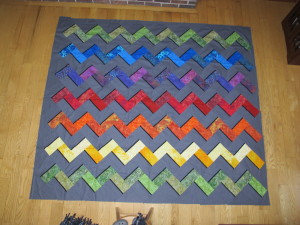Just like any other project or task there’s a beginning, a middle and an end. It takes a lot of time and preparation to begin and finish a quilt. When beginning a quilt, you must take the time to explore the many options on how you are going to go about making your quilt right down to the very fist stitch.
So where do you begin? It’s the easiest and hardest part of the process but once you get started you are on the path to making progress. However, there are different ways people can go about starting a quilt. Let’s explore the different options of where to begin when making a quilt.
1.) Start with a color
One way to start your quilt project is by first deciding what colors to incorporate in the quilt. Choosing your color scheme first will have an affect on what kind of style and or pattern of quilt you will want. If you prefer picking your colors as your first step to starting your quilt, a great way to choose colors is using a color wheel to help you match colors together. Also it’s important to remember that warmer colors for instance red, yellow and oranges appear closer together while cooler colors such as blues and greens will appear as farther away which can have an affect on the overall appearance of your quilt.
2.) Start with a fabric
Starting with fabric is also another way to begin your project. It’s important to have an idea of what kind of fabric you want to use especially if the quilt will be used for a bed cover. The type of fabric you choose may depend on the current weather as well such as choosing lighter fabric for the summer and heavier fabric for the winter.
Another tip when picking out fabric for your quilt is to always buy a little more than you need. This saves you extra time from not having to run back to the store to get extra material if it turns out you needed more than expected. If you don’t use the extra fabric you can save it for future projects and or make a rag quilt out of all of your leftover scraps of fabric.
3.) Start with a pattern
Picking out your pattern is also another great way to start your quilt if you prefer knowing how your quilt is going to be laid out first before deciding anything else. There are limitless patterns to choose from, some more simple and others more intricate. Don’t get too flustered by the large amount of options of patterns to pick from, simply spend a good 10 to 15 minutes looking and then decide on a pattern that pleases you and you won’t find yourself dwelling on it too much.
4.) Plan around the person or purpose the quilt is for
Most often when quilter’s start a quilt we normally have an idea of whom the quilt is for or where it will be place in the household. Some times this is how people actually begin their quilt project by deciding the purpose for the quilt and taking their next steps from there.
So how do you begin your quilts? Do you first start by picking out the color, pattern or fabric? Share with us how you start a quilt on our mobile app.
Live Well. Quilt Well.
